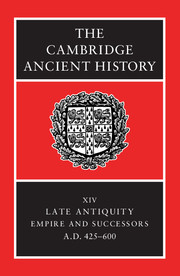Book contents
- Frontmatter
- PART I CHRONOLOGICAL OVERVIEW
- PART II GOVERNMENT AND INSTITUTIONS
- PART III EAST AND WEST: ECONOMY AND SOCIETY
- PART IV THE PROVINCES AND THE NON-ROMAN WORLD
- 18 The north-western provinces
- 19 Italy, A.D. 425–605
- 20 Vandal and Byzantine Africa
- 21a Asia Minor and Cyprus
- 21b Syria, Palestine and Mesopotamia
- 21c Egypt
- 22a The Sasanid monarchy
- 22b Armenia in the fifth and sixth century
- 22c The Arabs
- 23 The Balkans and Greece 420–602
- PART V RELIGION AND CULTURE
- Conclusion
- Chronological Table
- BIBLIOGRAPHY
- Index
- References
22c - The Arabs
from PART IV - THE PROVINCES AND THE NON-ROMAN WORLD
Published online by Cambridge University Press: 28 March 2008
- Frontmatter
- PART I CHRONOLOGICAL OVERVIEW
- PART II GOVERNMENT AND INSTITUTIONS
- PART III EAST AND WEST: ECONOMY AND SOCIETY
- PART IV THE PROVINCES AND THE NON-ROMAN WORLD
- 18 The north-western provinces
- 19 Italy, A.D. 425–605
- 20 Vandal and Byzantine Africa
- 21a Asia Minor and Cyprus
- 21b Syria, Palestine and Mesopotamia
- 21c Egypt
- 22a The Sasanid monarchy
- 22b Armenia in the fifth and sixth century
- 22c The Arabs
- 23 The Balkans and Greece 420–602
- PART V RELIGION AND CULTURE
- Conclusion
- Chronological Table
- BIBLIOGRAPHY
- Index
- References
Summary
INTRODUCTION: THE QUESTION OF SOURCES
In the present state of our knowledge it is not difficult to describe the physical setting for pre-Islamic Arabian history, and new archaeological discoveries in Saudi Arabia, Yemen, Jordan and the Gulf are producing much valuable and unique evidence. Over the past century a vast body of epigraphical material – some 50,000 north and south Arabian inscriptions and the inscribed sticks now emerging by the hundreds in northern Yemen – has provided a wealth of information on the societies of the peninsula, especially the bedouins. But all this seldom provides a coherent picture of the course of events, as opposed to vignettes and bare details, and thus does not replace a literary historical tradition. There are external epigraphic records of the Arabs and Arabia, and historical sources – especially in Greek and Syriac – are often helpful. But this information too is profoundly discontinuous, and in any case represents the perspective of outsiders who regarded the Arabs as barbarian marauders and most of Arabia as a menacing wasteland.
There is voluminous material on the subject in the Arabic sources, but herein lies the problem. The relevant accounts, including a vast bulk of poetry, are frequently attributed to the pre-Islamic period or otherwise presented as describing events and conditions of that time, but apart from the Qur’ān the sources containing these accounts are at least two centuries later. In times past it seemed reasonable simply to compare the various accounts to determine which seemed most likely to be true.
- Type
- Chapter
- Information
- The Cambridge Ancient History , pp. 678 - 700Publisher: Cambridge University PressPrint publication year: 2001

